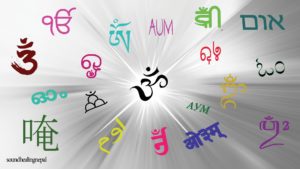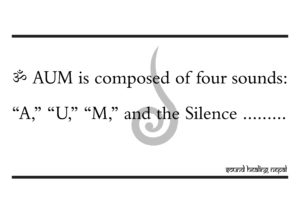ॐ तत्सदिति निर्देशो ब्रह्मणस्त्रिविध: स्मृत: |
ब्राह्मणास्तेन वेदाश्च यज्ञाश्च विहिता: पुरा ||
Auṁ tat sad iti nirdeśho brahmaṇas tri-vidhaḥ smṛitaḥ brāhmaṇās tena vedāśh cha yajñāśh cha vihitāḥ purā
Chanting AUM, the acts of yagna (fire ritual), dāna (charity) and tapas (austerity) as enjoined in the scriptures, are always begun by those who study the Brahman.
— Bhagavad Gita
Aum is pranava mantra (the advaita-mantra, the essence of all mantras) which connotes the Realisation of the Self as also the Supreme which indeed are one and the same and the Absolute Paramatma. Aum is the vibrational bridge between matter and spirit. Aum is the all-comprehensive sound symbol of Brahman, it represents the manifested state of Brahman by its audible sound,and the unmanifested by its inaudible. The more we talk about Aum, the less we express it. Chanting Aum has been quoted as “panacea” for almost every ailment.
My father and my guru taught me how to chant, and I have shared their wisdom with others by guiding them in their chanting. Although there is no wrong way of doing it, a possibility of profound improvement always exists.
There is no such thing as correct time to chant, similar to there being no correct time for eating or drinking. More importantly, follow your inner voice that ignites your wish to chant. But if you want to set a habit, sunrises and sunsets are preferred, since they mark the auspicious beginning and ending of a day. Avoid chanting immediately after a meal and make sure to clean yourself well after using bathrooms.
The way I was taught by my father is to find a place that you consider clean and pure. As long as the place you have chosen to chant is away from noise and too many people, you are good to go. If you have a shrine in your room, it is even better. Chanting Aum can be a great experience out in the nature or at a quiet secluded place away from the crowd and city noises.
Meditation and chanting are performed in a cross-legged posture mainly in Vajrasana, Sukhasana, Padmasana or Ardha Padmasana. If you are not comfortable with sitting like this, you can choose another posture. It is important to feel comfortable and relaxed. For sitting, choose a firm and in-moveable surface like grass, a yoga matt or a cushion. You can also sit in your bed or even at your work desk in your office.
Breathing is the most important part in chanting Aum. Take a few slow and deep breaths to make yourself comfortable and relaxed. Gently close your eyes and bring your awareness to your hearing sense. Concentrate on every sound coming from any source around you, one by one. Examples are the sound of cars, birds, people etc. Start chanting slowly as you exhale, replacing your exhalation with the chant. The most important thing to keep in mind is to equally emphasize each syllable, including “silence”. Chanting should start with a very relaxed and short interval, gradually building into longer and deeper chants.
The 3 aksharas (letters) of Aum are well explained in the Prashna Upanishad as — three levels of Soul knowledge, the lowest level being partial from meditating on the first letter of Aum, that is A. This leads to a quick rebirth, but with ethical strengths and consequently greatness. The intermediate level of self-knowledge is akin to meditating on two letters of Aum, that is A and U. The intermediate level of self-knowledge leads the individual to gain ethical behavior and the world of Manas (moon, mind), he first enjoys the heavenly life and thereafter is reborn to the world of man. The person who meditates on all aspects of self, that is all three syllables A, U and M, reaches full self-knowledge, is liberated from all suffering, sin and fears, reaches the world of Brahman. Such a person “beholds the soul as universal, pervading in all creatures, and eternal”.
It is not mandatory to chant Aum in every breath. In fact, focussing only on the breathing in between the chants can be a great way to relax mind and body. The duration of chanting each syllable should be uniform. For example “AAUUMM,” or “AAAAUUUUMMMM,” and not “AAAUMM” or “AUUUUUMMM.”
Aum is the manifested cosmic energy in all matter, hence a non-dual aspect that brings entire creations into nirguna (without material qualities) singularity. Chanting Aum with a group can be a great experience, especially if the group is large with people of different ethnicities, ages, orientations, religions and professions. I love chanting Aum after my yoga sessions, along with some Vedic hymns and mantras. There is such an overwhelming feeling of unity and blissfulness among the people after the chant. Chanting Aum in a group produces immense positive vibrations, which charge up the entire vicinity.
It is believed that no occasion or ritual is complete without the chanting of Aum. After you have chanted to your satisfaction gently open your eyes and take a deep breath and chant “Aum Shanti Shanti Shanti.” This basically means invocation of peace or deep settlement in body, speech and the mind. You can gently move your toes and make fists followed by normal movements of your body parts.
The benefits of chanting Aum are so vast that the more we talk the less we express, and so much happens on the metaphysical level that we cannot express these benefits with mere words. Nevertheless, below are some that are commonly accepted and appreciated by the scholars and practitioners.
– purifies the environment around you and invocation of positivity;
– improves the production of endorphin, which makes you feel relaxed and refreshed;
– increases cardio vascular efficiency by regulating the blood pressure and enhancing the heart beat;
– improves the thyroid gland, vocal cords enhancement of speech;
– helps in cleansing the mind and liberating the emotions;
– helps in bringing person’s awareness to the present state of mind;
– brings of a feeling of oneness within yourself and also with others.
How to Chant Om\AUM using Singing bowls
Below are some references from different Upanishads (Source : wikipedia:)
“He who utters Om with the intention ‘I shall attain Brahman’ does verily attain Brahman.” – Taittiriya Upanishad 1.8.1
“The Self is of the nature of the Syllable Om…Meditate on Om as the Self” – Mandukya Upanishad 1.8.12, 2.2.3)
“The form of meditation that came to manifest as the foremost of all, for the regeneration of all seekers, was the First Word, indicative of Brahman [God]: the Syllable Om. Meditation on Om should be resorted to by seekers after liberation. This Syllable is the Supreme Brahman.” – Atharvashikha Upanishad 1:1,2
“God is the Syllable Om, out of Him proceeds the Supreme Knowledge.” – Svetasvatara Upanishad 4:17
“Om is Brahman, the Primeval Being. This is the Veda which the knowers of Brahman know; through it one knows what is to be known.” – Brihadaranyaka Upanishad 5.1.1
“One should meditate on this Syllable [Om].” – Chandogya Upanishad 1.1.1
“The Syllable Om is the bow: one’s self, indeed, is the arrow. Brahman is spoken of as the target of that. It is to be hit without making a mistake. Thus one becomes united with it [Brahman] as the arrow becomes one with the target.” – Mundaka Upanishad 2.2.4
The subject is so vast that no matter how much I try to write I will always miss out something. If you think I have missed out very important part of have written something irrelevant please notify me.
I am looking forward for your suggestions and guidance.
Namaskar


Comments are closed.